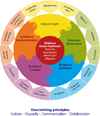1. Graham ID, Logan J, et al. Lost in knowledge translation: time for a map? J Contin Educ Health Prof. 2006; 26:13–24.
2. Lockwood CS, Aromataris E, Munn Z. Translating evidence into policy and practice. Nurs Clin North Am. 2014; 49(4):555–566. DOI:
10.1016/j.cnur.2014.08.010.
3. Cane J, O'Connor D, Michie S. Validation of the theoretical domains framework for use in behaviour change and implementation research. Implement Sci. 2012; 7:37. DOI:
10.1186/1748-5908-7-37.
4. Colquhoun HL, Squires JE, Kolehmainen N, Fraser C, Grimshaw JM. Methods for designing interventions to change healthcare professionals' behaviour: A systematic review. Implement Sci. 2017; 12:30. DOI:
10.1186/s13012-017-0560-5.
5. Jordan Z, Lockwood C, Aromataris E, Munn Z. The updated JBI model for evidence-based healthcare. Adelaide: The Joanna Briggs Institute;2016.
6. Missal B, Schafer BK, Halm MA, Schaffer MA. A university and health care organization partnership to prepare nurses for evidence-based practice. J Nurs Educ. 2010; 49(8):456–461. DOI:
10.3928/01484834-20100430-06.
7. Burns HK, Dudjak L, Greenhouse PK. Building an evidence-based practice infrastructure and culture: A model for rural and community hospitals. J Nurs Adm. 2009; 39(7-8):321–325. DOI:
10.1097/NNA.0b013e3181ae966a.
8. Everett LQ, Sitterding MC. Transformational leadership required to design and sustain evidence-based practice: A system exemplar. West J Nurs Res. 2011; 33(3):398–426.
9. Pravikoff DS, Tanner AB, Pierce ST. Readiness of U.S. nurses for evidence-based practice. Am J Nurs. 2005; 105(9):40–51.
10. Robinson JS, Turnbull DA. Changing healthcare organizations to change clinical performance. Med J Aust. 2004; 180:6 Suppl. S61–S62.
11. Stetler CB, Ritchie JA, Rycroft-Malone J, Schultz AA, Charns MP. Institutionalizing evidence-based practice: An organizational case study using a model of strategic change. Implement Sci. 2009; 4:78. DOI:
10.1186/1748-5908-4-78.
12. Waters D, Crisp J, Rychetnik L, Barratt A. The Australian experience of nurses' preparedness for evidence-based practice. J Nurs Manag. 2009; 17(4):510–518.
13. Weeks SM, Marshall J, Burns P. Development of an evidence-based practice and research collaborative among urban hospitals. Nurs Clin North Am. 2009; 44(1):27–31. DOI:
10.1016/j.cnur.2008.10.009.
14. Jordan Z, Donnelly P, Pittman P. A short history of a big idea: The Joanna Briggs Institute, 1996-2006. Melbourne: The Joanna Briggs Institute;2006.
15. Ashktorab T, Pashaeypoor S, Rassouli M, Alavi-Majd H. Nursing students' competencies in evidence-based practice and its related factors. Nurs Midwifery Stud. 2015; 4(4):e23047. DOI:
10.17795/nmsjournal23047.
16. Farokhzadian J, Khajouei R, Ahmadian L. Evaluating factors associated with implementing evidence-based practice in nursing. J Eval Clin Pract. 2015; 21(6):1107–1113. DOI:
10.1111/jep.12480.
17. Pearson A, Weeks S, Stern C. Translation science and the JBI model of evidence-based healthcare. . Philadelphia: Lippincott Wiliams & Wilkins;2011.
18. Choi M. Pain management among patients with cancer in an acute care setting: A best practice implementation project. JBI Clinical Fellows Monograph. The Joanna Briggs Institute;2010.
19. Chung SK. Chemotherapy-induced nausea and vomiting management among cancer patients with chemotherapy in an acute care setting: A best practice implementation project. JBI Clinical Fellows Monograph. The Joanna Briggs Institute;2010.
20. Lockwood CS, Lee YM. Evidence-based nursing: A Singaporean perspective Favourite publication. Singap Nurs J. 2015; 42(2):8–12. DOI:
10.1155/2012/490647.




 PDF
PDF ePub
ePub Citation
Citation Print
Print




 XML Download
XML Download